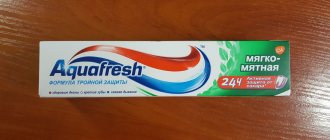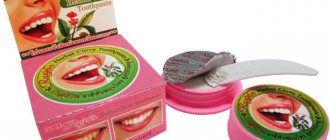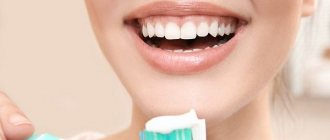As soon as your baby has teeth, you need to start caring for them. To do this, use special children's toothpastes with safe fluoride or components that replace it, which allow you to carefully care for thin children's enamel without harming the child's health and accustoming him to oral hygiene. It is imperative that children's toothpastes contain vitamins for children's teeth - at a minimum, calcium and fluoride to strengthen the enamel.
To attract the attention of a child, children's toothpastes are produced in beautiful colored packaging, often with surprises and souvenirs inside, and have various natural flavors and colors. Different manufacturers rank their products by age: from 0 to 3 years, from 4 to 8, from 8 to 14, and from 14 they recommend using regular toothpaste for adults. Along with toothpastes, on the shelves of stores and pharmacies you can find tooth gel, foam for baby teeth, and mouth rinses. All this allows parents to take care of their children with ease, and kids have the pleasure of learning to be neat and healthy.
Therapeutic and prophylactic toothpastes
Therapeutic and prophylactic pastes contain various biological additives intended for daily oral care, as well as for the prevention of caries, diseases of the oral mucosa, and periodontal disease. All therapeutic and prophylactic toothpastes are divided, depending on the biologically active substances included in their formulation, into several groups:
- Pastes containing herbal preparations.
- Salt toothpastes.
- Pastes used for xerostomia.
- Toothpastes that reduce tooth sensitivity.
- Toothpastes containing enzymes.
- Toothpastes containing various biologically active additives.
- Anti-caries toothpastes.
Which pasta should I buy?
All products from the category of professional, therapeutic or preventive toothpastes should be prescribed only by a dentist based on a visual examination and the results of a diagnostic examination. The scheme of use and duration of the course are also determined by a specialist.
Table. Which pasta should I buy?
| Purpose of use | What pasta to buy |
| Daily hygiene and oral care, breath freshening. | “Artek”, “Family”, Vita. |
| Strengthening tooth enamel and correcting mineral balance. | "Pearls", "Arbat". |
| Treatment of infectious and inflammatory diseases of the oral cavity (for example, stomatitis, periodontitis, etc.) | “Balsam”, “Pomorin”, “Amodent”, “Boroglycerin”. |
| Restoring normal acidity levels using soda toothpastes. | “Dental”, “Mildfresh”, “Aquafresh soda”, “Colgate soda”. |
| Treatment of hyperesthesia of tooth enamel. | "Sensodyne", "Elgifluor", "Biodent sensitive". |
| Teeth whitening, dissolution of dental plaque. | “Aquafresh whitening”, “Colgate active oxygen”. |
Choosing a toothpaste
If there is a pronounced putrid odor from the mouth, the doctor may prescribe products that contain sorbing elements. They effectively bind and remove pathogenic bacteria and their metabolic products, which can be one of the causes of unpleasant odor. It should be noted that the use of this category of pastes is justified only after excluding diseases of the digestive system - gastritis, pancreatitis, etc.
- What happens if you eat toothpaste?
How not to make a mistake when choosing toothpaste
Despite the wide variety of toothpastes, choosing the right product without the help of a specialist is not easy. To choose the right hygiene products, you need to know the types of pastes and their differences, as well as have an idea of the properties of the main ingredients used in the production of pastes of various groups. It is best to entrust the selection of hygiene and prevention products to a dentist, who will prescribe a toothpaste that meets the needs of a particular patient. How many minutes you need to brush your teeth, read on our website.
Toothpastes containing herbal preparations
Pastes containing herbal preparations improve metabolic processes, tissue regeneration, help reduce bleeding gums, and have excellent deodorizing properties.
In addition to the above mentioned components, their composition also includes adult and children’s dental vitamins, extracts, infusions of medicinal plants, salts, microelements, and enzymes. These pastes are intended both for everyday oral care for preventive and hygienic purposes, and for the prevention of caries, periodontal diseases, non-carious lesions, and diseases of the oral mucosa.
The main types of therapeutic and prophylactic additives included in toothpastes are:
- antiseptics;
- extracts of medicinal plants;
- other active substances.
Local use of antiseptics as part of oral hygiene products is currently becoming widespread. An antimicrobial drug for topical use must meet a number of requirements: high antimicrobial effectiveness, a wide spectrum of action against representatives of opportunistic microflora of the oral cavity, absence of microbial resistance to the drug and pronounced side effects. The most popular antimicrobial ingredients are chlorhexidine and triclosan.
Chlorhexidine is a broad-spectrum antiseptic. Numerous clinical studies have demonstrated the high effectiveness of chlorhexidine against both anaerobic and aerobic bacteria. The mechanism of action of chlorhexidine is not fully understood. The literature describes three main side effects of chlorhexidine:
- superficial staining of teeth and other surfaces in the oral cavity, which is temporary;
- increased formation of tartar:
- short-term change in taste sensations.
For a long time, the introduction of chlorhexidine into toothpastes was problematic due to its poor compatibility with abrasives. However, modern industry has made it possible to create a number of systems that allow the introduction of the described ingredient into abrasive pastes.
Triclosan is a broad-spectrum antiseptic, an ester compound, a phenol derivative. Depending on the concentration, triclosan can have a bacteriostatic and bactericidal effect. The bacteriostatic effect of triclosan is due to the suppression of the absorption of essential amino acids by bacteria. The bactericidal effect is a consequence of disorganization of the cytoplasmic cell membrane. Triclosan has a broad spectrum of antimicrobial activity and is highly compatible with other toothpaste ingredients. It has become widespread because over a decade of its use, not a single clinical case of the development of resistant strains of bacteria or the development of dysbiosis has been described. Toothpaste with triclosan has an anti-inflammatory effect, promoting the accelerated elimination of gingivitis and suppression of pathological processes in periodontitis.
Extracts of medicinal plants are represented in a fairly wide range. These include herbal antiseptics, antioxidants, amino acids, vitamins, macro- and microelements, and compounds with immunocorrective properties. Toothpastes with plant extracts can have a hemostatic, anti-inflammatory, stimulating, wound-healing effect, as well as normalize tissue trophism. Toothpastes may contain extracts of chamomile, sage, nettle, St. John's wort, kelp, mint, calendula, eucalyptus, as well as tea tree oil and some others.
The composition of toothpastes also includes potassium and sodium tetrapyrophosphates, zinc and aluminum compounds, potassium nitrate, strontium chloride and sodium citrate.
Soluble pyrophosphates prevent the mineralization of dental plaque and reduce the amount of supragingival tartar by 32-45%.
Potassium nitrate, strontium chloride and sodium citrate help eliminate tooth sensitivity. The use of such toothpastes by patients with periodontal diseases is especially important, when the pathology results in exposure of the necks of teeth, as well as the formation of wedge-shaped defects.
Zinc and aluminum compounds prevent the precipitation of dyes on the surface of the enamel and slow down the rate of formation of tartar. Toothpastes containing these compounds are usually recommended for smokers and prescribed after professional teeth cleaning.
TOOTHPASTE “Forest”
Lesnaya toothpaste from Nevskaya Cosmetics contains pine chlorophyll-carotene paste, which includes chlorophyll, carotene, balsamic resins, and tocopherol. Chlorophyll preparations have long been known and used in medical practice. They help stop bleeding and activate tissue regeneration processes and have a deodorizing effect.
In 1995, the RA Influenza Institute conducted a study of the antiviral activity of Lesnaya toothpaste. Based on the research results, the following conclusions were drawn:
- the presence of antiviral activity of the chalk-based toothpaste “Lesnaya” against a number of respiratory viruses has been shown;
- using at least 1 g of toothpaste per toothbrush and brushing teeth for at least 2 minutes leads to the inactivation of respiratory viruses, which ensures the sanitization of the oral cavity and the peripharyngeal ring and will prevent the development of the disease.
TOOTHPASTE “NEW PEARL SEVEN HERBS”
Toothpaste “New Pearl Seven Herbs” contains a whole complex of medicinal plant extracts.
- St. John's wort extract has anti-inflammatory, hemostatic, epithelializing and astringent properties.
- Stinging nettle extract has a hemostatic and epithelializing effect, reduces the release of wound exudate, and increases basal metabolism.
- Peppermint extract helps reduce pain sensitivity and has an antiseptic effect.
- Chamomile extract has a disinfectant, anti-inflammatory, analgesic, anti-allergic effect and accelerates tissue regeneration processes.
- Salvia officinalis extract provides an astringent, anti-inflammatory, and disinfectant effect. It is widely used for long-term and poorly healing wounds and oral ulcers.
- Calendula officinalis extract, due to its pronounced anti-inflammatory, epithelializing and regenerating effect, is often used for gingivitis, stomatitis and cracks in the corners of the mouth.
- Echinacea extract has a pronounced immunomodulatory effect.
TOOTHPASTE “NEW PEARL EUCALYPTUS”
Having studied and analyzed the clinical effectiveness of eucalyptus extract, I developed a new toothpaste formula - “New Pearl Eucalyptus”. This extract has a pronounced local anesthetic, vasoconstrictor, anti-inflammatory and regenerating effect, which makes it possible to successfully use it in the treatment of periodontal diseases. In addition, this paste perfectly freshens breath.
TOOTHPASTE “NEW”
“Novinka” toothpaste is one of the best domestic toothpastes both in terms of hygienic (cleansing) and taste properties, and in terms of therapeutic effects on oral tissues. It contains: carotene, vitamins C and K, tocopherol, chlorophyll. The paste has a good cleansing effect, helps reduce inflammatory processes in the periodontium, eliminates bleeding and increases the regenerative activity of the oral mucosa.
TOOTHPASTE “CAMOMILE”
“Chamomile” toothpaste contains hydroalcoholic infusions of St. John’s wort and chamomile, has an anti-inflammatory, antiseptic and astringent effect, and has good cleansing and taste properties.
TOOTHPASTE “SPUTNIK”
Sputnik toothpaste contains spinach extract and aqueous-alcoholic infusion of eucalyptus. Spinach extract contains significant amounts of vitamins C and P and chlorophyll. The composition of eucalyptus infusion includes essential oils and tannins. The paste has a good therapeutic and prophylactic effect on the mucous membrane of the oral cavity and periodontal disease.
CHILDREN'S TOOTHPASTE “BURATINO”
Children's toothpaste "Buratino" contains extracts of chamomile, yarrow and cloves, has a pronounced anti-inflammatory effect, and is recommended for gingivitis.
CHILDREN’S TOOTHPASTE “NUTCRACKER”
Children's toothpaste "Nutcracker" is prepared on the basis of calendula extract, the main components are carotene, lyconin, essential oils, organic acids. The paste has a pronounced anti-inflammatory effect and has phytoncidal properties.
TOOTHPASTE “PARADONTAX”
“Paradontax” is a toothpaste made on the basis of natural substances, prevents the development of bleeding and inflammation of the gums, inhibits the development of bacteria without disturbing the normal microflora of the oral cavity, neutralizes the acidic products of the breakdown of sugars, helps strengthen the gums and teeth, and gives a long-lasting feeling of cleanliness and freshness. The paste contains: peppermint, myrtle, sage, chamomile, ratania, sodium bicarbonate, which allows this paste to be used for the prevention and treatment of inflammatory periodontal diseases.
From all of the above, we can conclude that therapeutic and prophylactic pastes are recommended for widespread use in the complex treatment of periodontal diseases and the oral mucosa.
Salt toothpastes
Salt toothpastes contain various salts and mineral components that improve blood circulation, stimulate metabolic processes in the periodontium and oral mucosa, cause an increased outflow of tissue fluid from the inflamed gums, and have some analgesic effect.
Salts help dissolve mucus, prevent the formation of soft plaque, and promote detachment of microorganisms from the surface of tooth enamel.
TOOTHPASTE “BALM”
The composition of the Balsam toothpaste includes healing brine from the Kuyalnitsky estuary, famous for its unique properties. The paste contains a complex of microelements that have a positive effect on periodontal tissue and promote better cleaning of the oral cavity.
TOOTHPASTE “JUBILEE”
“Yubileinaya” toothpaste contains brine from the Morshyn mineral water source, the only one in the world with a high potassium content with an optimal content of sulfate-magnesium components. This combination of chemical elements has a beneficial effect on blood circulation in the oral mucosa and periodontal tissues, improves trophism and has a pronounced anti-inflammatory and cleansing effect.
In the beginning there was sand and chalk
Toothpaste and brush are everyday things with which our day begins and ends. However, they were once a real luxury. The ancient Egyptians were the first to think about oral hygiene and began to use sand, ash, ground stones and animal horns as a cleaning agent, and their own finger replaced the brush. In the 4th century BC. The great healer Hippocrates recommended using mixtures of pumice with the addition of wine vinegar, which are more gentle on tooth enamel, to prevent dental diseases. At the end of the 18th century, little had changed. For example, the British brushed their teeth with powders that included crushed brick, crushed bark and coal chips.
The prototype of modern toothpaste was invented by Americans in the 19th century. This time there were no stones or ash. Teeth cleaning products were a mixture of chalk powder, neutral soap and aromatic additives. It was only in 1873 that Colgate released the first toothpaste in glass jars, which replaced tubes two decades later. They were invented by dentist Washington Sheffield of New London. But Colgate beat the inventor by quickly registering a patent for itself. An interesting fact is that in Russia, most people at that time continued to brush their teeth with chalk-based powder, and only in the 50s it became possible to buy a familiar tube of toothpaste in stores.
Toothpastes used for xerostomia
With xerostomia or decreased salivation, the activity of antimicrobial defense decreases and the degree of development of inflammatory processes in the oral cavity increases.
In such conditions, it is advisable to use toothpastes with low foaming properties and the absence of irritating components, with the addition of enzymes (lysozyme, lactoferrin, lactoperoxidase).
To accelerate the regenerative processes of the mucous membrane, biologically active components are introduced into toothpastes - enzymes, oil solutions of vitamins A and E, carotoline.
An example would be the following toothpastes: Biotene, Weleda Salf, Zendium.
Read what is written on the package!
Perhaps the only question that buyers ask is whether to take a product with fluoride or calcium. Moreover, the majority prefer calcium, considering fluoride harmful to the body. This is true and not true at the same time.
In fact, fluoride prevents tooth decay. However, its excess can lead to fluorosis. This disease manifests itself as white spots on the teeth. Those products that can be seen on store shelves, as a rule, do not contain much fluoride and are not capable of leading to pathology. Another thing is special pastes in pharmacies; they should only be purchased with a doctor’s prescription.
Ideally, it would be nice to know what percentage of fluoride is in the water that comes out of the tap in your home. If this coefficient is large, then choose a paste where fluorine is not the main component.
What are the benefits of calcium?
- It restores the structure, saturating the enamel with useful minerals.
- The hard tissue of the tooth consists of more than 30% calcium. In the paste, the component serves to strengthen its mineral base.
- Calcium helps neutralize excess acidity, which is harmful to enamel.
Chamomile, sage and other herbs presented on the packaging are more of a marketing ploy. The consumer trusts everything that seems more natural to him, with a minimal chemical composition.
The SOS signal on the package means the following components:
- SLS is sodium lauryl sulfate. It gives abundant foam and a feeling of crystal clear enamel. Many manufacturers do not include it in pastes, as it is considered harmful to health. This is not a proven fact, so the choice is yours;
- NaHCO3 - sodium bicarbonate, baking soda. Slowly but surely destroys tooth enamel;
- CaCO3 is calcium carbonate, ordinary chalk, which is often included in cheap products. May leave scratches on enamel. You can use a paste with this component only if you don’t mind your teeth;
- Al2O3 – aluminum oxide. In most countries of the world, this substance is prohibited. There is no such ban in Russia, although the negative impact of this chemical component has been proven. Its main destructive property is the killing of brain cells;
- Triclosan – it is used as an antibacterial additive. However, by killing microorganisms in the oral cavity, it disrupts hormonal balance. The consequence is cancer, problems with the thyroid gland and heart.
Toothpastes that reduce tooth sensitivity
Toothpastes to reduce the sensitivity of tooth enamel contain biologically active components:
- potassium nitrate,
- potassium citrate,
- sodium citrate,
- strontium chloride,
- hydroxyapatite.
SENSODYNE F TOOTH PASTE
Potassium chloride, which is part of Sensodyne F toothpaste, has similar properties.
These compounds, when interacting with the organic substances of the enamel, create a protective barrier that prevents pain reactions to temperature or chemical stimuli (hot, cold, sweet, sour), as well as to mechanical stimuli (when brushing teeth).
Components included in some toothpastes, such as Remodent (3%), calcium glycerophosphate (0.13%), synthetic hydroxyapatite (2 to 17%), help reduce the increased sensitivity of enamel by closing the entrance holes of the dentinal tubules.
This group also includes toothpastes such as Oral-B Sensitive, Lacalut Sensitive.
Anti-caries pastes that restore enamel
Such products are designed to combat enamel demineralization and prevent the development of caries at the white spot stage. Pastes are based on calcium compounds or fluorides. You should not use products that contain both types of compounds. The fact is that fluorine and calcium react and form an insoluble residue, which means that during cleaning no active ions are released and no recovery occurs.
Calcium-containing pastes can be used every day. They are designed to correct mild thinning of the enamel.
Fluoride-containing pastes are designed to restore seriously damaged enamel. They can only be used with the permission of a doctor, as there is a risk of getting excess fluoride in the body. This can lead to brittle bones and teeth. Such products are used no more than twice a week. For greater effectiveness, they can be alternated with calcium-containing pastes.
Toothpastes containing enzymes
Toothpastes containing enzymes are hygiene products with a high cleansing effect; they dissolve soft plaque, food debris, and nicotine plaque, thereby improving the hygienic condition of the oral cavity.
TOOTHPASTE “WHITE-PINK”
White-pink toothpaste contains a complex of proteolytic enzymes that dissolve soft plaque well and also reduces inflammation in the periodontium and oral mucosa.
“SPECIAL” TOOTH PASTE
“Special” toothpaste, in addition to enzymes, contains substances that help remove not only food debris, soft plaque, but also nicotine plaque from smokers. The increased cleansing effect of the paste is associated with the ability of enzymes to dissolve the protein-lipid bases of soft dental deposits without negatively affecting the tooth enamel.
TOOTHPASTE “SMILE”
“Smile” toothpaste contains urodan, magnesium sulfate and magnesium peroxide: all these components are capable of dissolving soft dental deposits, providing a good cleansing and anti-inflammatory effect.
TOOTHPASTE “ENCHARIER”
The Enchantress toothpaste contains, in addition to enzymes, a hydroalcoholic infusion of nettle and polyvinylpyrrolidone, which is a good paste for removing soft and pigmented plaque and helps reduce inflammation in the periodontium.
It follows from this that toothpastes containing enzymes are recommended for oral hygiene in the treatment of periodontal diseases and oral mucosa in the acute phase.
What kind of toothbrush should you have?
First recommendation. A toothbrush must have synthetic bristles . Nowadays it is important to be eco-friendly, but this is not the case when you should give preference to natural things. Any natural fiber (be it boar bristles or bamboo) has a porous structure, and inside it there is a channel that quickly fills with bacteria from dental plaque. There is no way you can clean the plaque from inside such bristles, so after the first uses, your eco-friendly toothbrush becomes a breeding ground for microorganisms.
Toothpastes containing various dietary supplements
Toothpastes containing biologically active additives have anti-inflammatory and regenerative effects, which allows them to be used in the treatment of gingivitis, periodontitis and other diseases of the oral mucosa.
TOOTHPASTE “PRIMA”
Prima toothpaste contains vitamin B5 and has anti-inflammatory and regenerative effects.
TOOTHPASTE “BOROGLYCERINE”
Boroglycerin toothpaste contains 10% boroglycerin, which provides it with active antiseptic, bacteriostatic, bactericidal, fungistatic and fungicidal effects. The paste is advisable to use for acute and chronic candidiasis, stomatitis, glossitis and cheilitis, as well as for inflammatory periodontal diseases (gingivitis, periodontitis and idiopathic periodontal diseases).
TOOTHPASTE “BERRY”
“Yagodka” toothpaste contains 7% boroglycerin, which also provides an antiseptic effect against Staphylococcus aureus. It is recommended to use it 3-4 times a day in the treatment of candidiasis.
TOOTHPASTE “NEW PEARL EXTRA”
“New Pearl Extra” is the first toothpaste that contains kelp seaweed extract, which enhances the body’s immune response. In a study conducted under the guidance of Professor Yu.A. Fedorov, it was found that this paste significantly reduces the severity of periodontitis due to the natural extracts included in the formulation.
Anticarious toothpastes
Anti-carious toothpastes strengthen the mineral tissues of the tooth and prevent the formation of plaque. This is achieved by introducing fluorine, phosphorus and calcium compounds into toothpastes. In toothpastes, to saturate hard tooth tissues with fluoride ions, it is necessary to use weak concentrations of fluoride, not exceeding 2% in the tube. Toothpastes containing 1-3 mg of fluoride per 1g of toothpaste are effective.
Studies of the caries-preventive effect of fluoride-containing toothpastes have shown that their use reduces the increase in caries in children by 15–35%.
The most active anti-carious effect of fluoride and pastes containing it manifests itself during the period of maturation of tooth enamel, i.e. in childhood. Later, the anti-caries effectiveness of fluoride-containing pastes is significantly reduced. Thus, it is advisable to use them to prevent dental caries, mainly in childhood. The use of fluoride-containing toothpastes in our country is associated with some peculiarities. A huge space with different climatic and geographical conditions and uneven fluoride content in drinking water and food products in certain areas of the country does not allow the widespread and widespread use of fluoride-containing toothpastes, since they can get into areas and areas where the human body is already sufficient or large amounts of fluoride are supplied. In this case, fluoride-containing toothpastes are not only useless, but their use can be harmful. In this regard, fluoride-containing toothpastes should be prescribed by a doctor individually, depending on the specified conditions of the region of the country. It is advisable that the purchase of toothpastes in different regions of the country be coordinated by dentists.
Most toothpastes contain fluoride. Despite all the positive qualities, fluoride-containing toothpastes do not have an anti-caries effect in 30-35% of cases. In this regard, other medicinal pastes have been developed that help strengthen tooth enamel. Most toothpastes contain dissolved fluoride and are used as an effective component for the prevention of caries.
When their concentration is up to 1500 mg/kg of toothpaste, they are considered harmless. Fluorides suppress the metabolism of bacteria contained in dental plaque, and therefore their ability to form acids that have a destructive effect on tooth enamel. In addition, fluorides inhibit the formation and spread of bacterial plaque. Fluorides also mineralize the hard tissue of teeth, thereby increasing their resistance to caries, increasing the resistance of teeth to acids. Amine fluoride is recognized as the most effective compound. It adheres better to teeth and is more effective than sodium fluorophosphate and sodium fluoride in inhibiting the formation of acids contained in dental plaque. The effect of fluorides is especially effective at a relatively low acid value (pH) of toothpastes.
In pastes presented on our market, the declared content of fluorine compounds is 0.8-0.9%. According to WHO recommendations (1984), the optimal concentration of fluoride ion in toothpastes should be 0.1%. Effective toothpastes contain 1-3 mg of fluoride per 1 g of toothpaste. Toothpastes for adults contain from 0.11% to 0.76% sodium fluoride or from 0.38% to 1.14% sodium monofluorophosphate. In children's toothpastes, fluoride compounds are found in smaller quantities (up to 0.023%).
The combination of sodium fluoride and calcium- and silicon-containing substances in the composition of some abrasive toothpastes represents a special fluoristat system.
To reduce the amount of plaque and inhibit the growth of tartar crystals, toothpastes include components such as triclosan, which has an antibacterial effect on gram-positive and gram-negative bacteria, and a copolymer that promotes the prolonged action of triclosan for 12 hours after brushing. The entry of fluoride into tooth enamel increases its resistance to acid demineralization due to the formation of structures more resistant to dissolution. For complete mineralization of hard tooth tissues and increasing their resistance to caries, in addition to fluorides, other inorganic elements are also necessary. Toothpastes containing potassium and sodium phosphates, calcium and sodium glycerophosphates, calcium gluconate, and zinc oxide have a pronounced anti-caries effect. A similar effect is achieved by toothpastes containing derivatives of chitin and chitosan, which have an affinity for proteins and are able to inhibit the adsorption of Streptococcus mutans, mitis, sanguis on the surface of hydroxyapatite. Components included in some toothpastes, such as Remodent 3%, calcium glycerophosphate 0.13%, synthetic hydroxyapatite (from 2% to 17%), help reduce the increased sensitivity of enamel by closing the entrance holes of the dentinal tubules.
In addition, biological substances are often added to anti-caries pastes: water-soluble vitamins for teeth for children and adults, herbal extracts, medicinal oils, which helps relieve inflammatory processes, i.e. Such pastes have a comprehensive effect on the oral cavity. Thus, anti-caries substances are designed to strengthen and restore hard dental tissue and reduce the solubility of enamel through mineralization.
TOOTHPASTE “ZODIAC”
In our country, Zodiac toothpaste is produced; the paste contains sodium fluoride and sea buckthorn oil, which have anti-caries, anti-inflammatory and epithelializing effects. Therefore, this toothpaste can be recommended for the prevention and treatment of caries in the white spot stage, as well as for periodontal diseases and oral mucosa.
“CHEBURASHKA” TOOTH PASTE
Cheburashka paste contains sodium fluoride, phosphates and microelements; it has an anti-caries effect and can be recommended for both children and adults.
TOOTHPASTE “FLUORODENT”
The group of fluoride-containing toothpastes includes “Ftorodent”; it contains sodium fluoride, which allows this paste to be used for the prevention and treatment of dental caries, as well as to reduce hyperesthesia of hard dental tissues; the paste can reduce caries susceptibility by strengthening the crystalline structure of tooth enamel.
TOOTHPASTES “PEARL” AND “ARBAT”
Toothpastes “Zhemchug” and “Arbat” are phosphate-containing therapeutic and prophylactic oral hygiene products. These pastes contain calcium glycerophosphate and an antiseptic; the pastes differ only in taste. Both pastes are very effective against caries and hyperesthesia of hard dental tissues: it is known that calcium glycerophosphate, applied topically, helps strengthen the enamel crystal lattice and activates mineralization processes.
TOOTHPASTE “CRYSTAL”
Kristall paste is also a fluoride-containing remineralizing hygiene product. In addition to sodium fluoride, the composition contains enzymes: ribonuclease and lysozyme, they contribute to the complete cleansing of the surface of the teeth, hydrolyzing food debris and soft plaque into low molecular weight water-soluble compounds. The paste is effective for caries in the white spot stage and periodontal diseases; it is able to consolidate the results of treatment, normalize metabolic and trophic processes in periodontal tissues and the oral mucosa.
TOOTHPASTE “REMODENT”
Remodent toothpaste is prepared on the basis of a preparation obtained from animal bones and contains soluble compounds of calcium, phosphate, and a number of macro- and microelements. Studies have shown the paste to be highly effective. Repeated use of this toothpaste leads to an improvement in the structure and composition of tooth enamel, making it more resistant to cariogenic influences, and reduces the permeability of dental tissues and their solubility in acids. The paste is effective for the prevention and treatment of caries in the white spot stage, with increased sensitivity of teeth to external irritants.
TOOTHPASTE “NEW PEARL TOTAL”
Toothpaste “New Pearl Total” effectively fights not only periodontal diseases, but also caries, since the microbial factor is the main factor in both cases. The anti-carious effect is provided by the fluoride included in its composition.
TOOTHPASTE “NEW PEARL TOTAL FRESH STRIP”
The family of toothpastes has recently been replenished with a new toothpaste, called “New Pearl Total Fresh Stripe”. In addition to triclosan, it contains a special polymer that prolongs the antibacterial effect of triclosan. Thanks to the introduction of a new component, this toothpaste offers long-lasting antibacterial protection.
TOOTHPASTE “BLEND-A-MED”
Blend-a-med toothpaste contains sodium fluoride, which, due to its high biological activity, is well absorbed by hard tooth tissues, providing maximum protection against caries. The fluoristat system of this toothpaste retains calcium in tooth enamel, thereby promoting the restoration of the hydroxyapatite crystal. This paste helps protect teeth from caries and keep them healthy.
There are several modifications of the Blend-a-med toothpaste: for children with baby teeth, for teenagers, universal paste and combined toothpaste. The latter, in addition to the fluoristat system, contains antibacterial agents and biologically active drugs, which make it possible to use this paste not only for the prevention and treatment of dental caries, but also for diseases of the oral mucosa and periodontal diseases. A universal paste that can prevent the formation of soft plaque and tartar.
TOOTHPASTE “AQUA-FRESH”
Aqua-fresh toothpaste also contains sodium fluoride, which has high biological activity, providing dental hard tissues with resistance to caries. The toothpaste has a pleasant taste, refreshes and deodorizes the oral cavity.
TOOTHPASTE “SIGNAL”
“Signal” refers to fluoride-containing toothpastes and has a therapeutic and prophylactic anti-caries effect.
“COLGATE” TOOTH PASTE
Colgate paste contains sodium fluoride, which provides protection against caries and increases caries resistance by restoring the hydroxyapatite crystal. The paste reduces the hypersensitivity of hard dental tissues, refreshes and deodorizes the oral cavity.
Colgate paste contains sodium fluoride, which provides protection against caries and increases caries resistance by restoring the hydroxyapatite crystal.
The paste reduces the hypersensitivity of hard dental tissues, refreshes and deodorizes the oral cavity.
By using therapeutic and prophylactic toothpastes, it is possible to regulate the supply of macro- and microelements into tooth tissue, promote the physiological process of “maturation” of tooth enamel and keep teeth healthy for many years. Systematic oral hygiene, regular removal of soft dental deposits have a beneficial effect on the gum mucosa, and its massage, which occurs during brushing, improves blood circulation in the periodontal tissues and activates metabolic processes, which fully ensures the health of the teeth and the tissues surrounding them.
Criterias of choice
You can determine which toothpaste is fluoride-free by the absence of:
- fluorides of sodium, aluminum, tin;
- monofluorophosphate;
- sodium fluorosilicate;
- fluorosilicic acid.
Calcium is present in pastes in the form of panotothenate, citrate, lactate, glycerophosphate or synthetic hydroxyapatite.
It’s difficult to choose the best fluoride-free toothpaste; each has its own advantages, let’s take a closer look.









